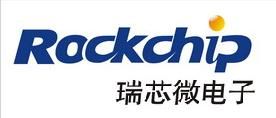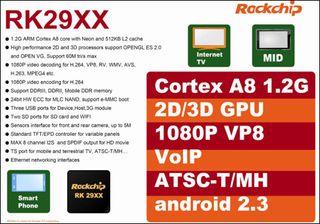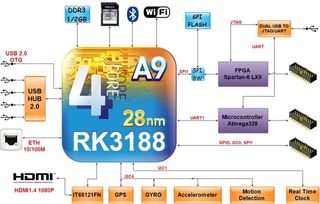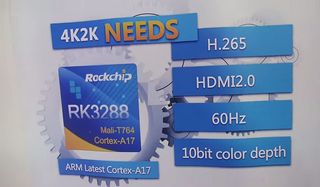The International ARM Race: Rise Of The Chinese SoC
Thanks to low prices and a gradual increase in both quality and performance, Chinese chip makers are starting to pose serious problems for Qualcomm, Nvidia and others.
Rockchip

Founded in 2001 and based in Fuzhou, China, the Fuzhou Rockchip Electronics Co. Ltd., or simply Rockchip, designs and develops integrated circuits, particularly SoCs. The company is a well-established ARM licensee, utilizing the IP company’s architecture for the majority of its products. Rockchip's focus has been predominantly on the tablet and personal media player (PMP) markets, so Rockchip SoCs do not include support for radios other than Wi-Fi.
| SoC | CPU Core | GPU Core | Max Resolution | Camera | Video Encode/Decode |
|---|---|---|---|---|---|
| RK2918 | Cortex A8 (1-core) @ 1.0-1.2 GHz | Vivante GC800 @ 575 MHz | 1280x800 | 5MP ISP | 1080p @ 30 FPS |
| RK3066 | Cortex A9 (4-core) @ 1.6 GHz | Mali-400 MP4 @ 400 MHz | 2048x1536 | 5MP ISP | 1080p @ 30 FPS (h.265/VP9 support) |
| RK3026 | Cortex A9 2-core) @ 1.0 GHz | Mali-400 MP2 @ 330 MHz | 1920x1080 | 5MP ISP | 1080p @ 30 FPS |
| RK3168 | Cortex A9 (2-core) @ 1.2-1.5 GHz | Mali-400 MP4 @ 400 MHz | 1920x1080 | 5MP ISP | 1080p @ 30 FPS |
| RK3188 | Cortex A9 (4-core) @ 1.6 GHz | Mali-400 MP4 @ 600 MHz | 2048x1536 | 5MP ISP | 1080p @ 30 FPS (h.265/VP9 support) |
| RK3288 | Cortex A17 (4-core) @ 1.8 GHz | Mali-T764 @ 400MHz | 3840x2160 | 13MP ISP | 1080p @ 30 FPS / 4k @30 FPS |
RK2918

Released in 2012, the RK2918 was Rockchip's first ARMv7 chip. It used a Cortex-A8 CPU and Vivante GC800 GPU, supporting a display resolution of up to 1280x800, though it could encode and decode video of up to 1080p. The notable feature of this processor is that it was among the first to support the open-source VP8 codec.
RK3066
Released in 2012, the Rockchip RK3066 is a 40 nm, 1.6 GHz, dual-core Cortex-A9 SoC coupled with the Mali 400 GPU and up to dual-channel DDR3 support. It was designed to compete with the dual-core Samsung Exynos 4, and benchmarks proved its mettle, with the RK3066 registering around 7000 points in AnTuTu at the time.

In some ways, it went beyond its competitors' capabilities, offering support for faster memory, an upper limit of 2 GB (though implementations were rare) and five-point multitouch panels up to 1920x1080 (which, as far as we understand, never surfaced in devices, perhaps due to it being a largely budget-focused chipset).
RK3066 was sold extensively in tablets from a wide variety of Chinese and European manufacturers, including Cube, Pipo, and Archos. In fact, Archos was still releasing RK3066-based devices in late 2012. That included some products in the company's budget line, Arnova, and the game-focused Gamepad, which includes a hardwired gaming controller. RK3066 also powered the OUYA competitor, GameStik.
RK3066 devices tended to be most popular in the budget 10-inch range of early- to mid-2012, and continued to sell well throughout the year. Another area of success for RK3066 was the HDMI stick form factor. Indeed, RK3066 quite clearly put HDMI Android Media devices on the map, with more than 20 such devices released over the 2012 period alone.
Interestingly, Archos released the 97 Titanium HD, which pushed the RK3066 beyond its theoretical limits by powering a 2048x1536 "Retinal" display. And while it didn't perform as smoothly as its 800p brothers in games, it still held its own in terms of browsing and general day-to-day tasks, proving the RK3066 to be extremely versatile.
RK3188
Building on the success of the RK3066, RK3188 ups the ante considerably by pushing into quad-core territory. The budget-oriented tablets that use it are in a performance tier previously reserved for premium devices like the Tegra 3-equipped Transformer Pad Infinity.

Excitement for this 28 nm quad-core Cortex-A9, Mali MP4-equipped SoC was so high that there was a record-breaking number of preorders for devices like the Cube U30GT2 and PIPO M4 Pro. The bump in GPU speed and CPU power meant that more devices with 1920x1200 screens were released, and the RK3188 SoC handled that gracefully, partly because almost all those devices came standard with 2 GB of DDR3 RAM. In fact, the only RK3188 devices that shipped with only 1 GB of RAM were budget HDMI media sticks.
Benchmarks put this chipset around the 14,000- to 18,000-point mark in AnTuTu, landing beyond Tegra 3's space at a lower price.
RK3168
Considering it has only a dual-core Cortex-A9 processor complex and a GPU that’s more commonly included with Cortex-A7-based SoCs, the RK3168 is a more budget-conscious revision of the RK3188. It's designed to ship in smaller, 7-inch tablets, which tend to be less expensive.
RK3288
The RK3288 is Rockchip's latest and most powerful SoC, and is expected to surface this year. It comes with a quad-core Cortex-A17 processor at 1.8 GHz, and a Mali-T760 GPU. Initially, Rockchip was supposed to use the Cortex-A12 core, but since ARM announced Cortex-A17 quite suddenly, improving Cortex-A12, Rockchip quickly updated its SoC to use the newer IP instead.

Cortex-A17 will target the mid-range market in 2015, while Cortex-A57 remains at the high end, possibly improved. Unfortunately, the -A17 core isn't based on the new and improved ARMv8 architecture, and it's still a 32-bit chip. That's disappointing for a piece of hardware surfacing in 2015, but Rockchip most likely chose it because of cost considerations. Rockchip sells some of the lowest-cost SoCs for mobile devices. It's also why the company chose the Cortex-A17 instead of something even more powerful for its mid-range chips.
On the GPU side, it doesn't look like Rockchip spares any expense, since the company is using a high-end Mali-T764 GPU. Considering Rockchip is mainly targeting tablets, it's not too surprising to see it match a high-end GPU with a more modest CPU. Tablets tend to use higher resolutions than phones, and a more powerful GPU can make sure the tablet doesn't overheat and doesn't use up the battery too quickly.
The GPU also supports the latest mobile graphics features, along with support for 4K video decoding. It even supports HDMI 2.0 and 10-bit color, in case you want to hook the tablet up to a 4K TV.
Rockchip recently partnered with Intel to build some 28 nm non-FinFET SoCs using the Atom core and branding. Intel hopes that with this partnership, it can lower the cost of Atom and push it into less expensive platforms. It remains to be seen how competitive these chips will be, particularly since Intel’s own 22 nm Atoms are barely fast enough to compete with high-end ARM chips. These SoCs will most likely be targeted at the mid-range market, and also use Intel's 3G modems. In the meantime, the ARM-based RK3288 will arrive with support for 4G LTE this year.
Stay on the Cutting Edge
Join the experts who read Tom's Hardware for the inside track on enthusiast PC tech news — and have for over 25 years. We'll send breaking news and in-depth reviews of CPUs, GPUs, AI, maker hardware and more straight to your inbox.
-
jossrik It'll be interesting to see where manufacturing goes in the future, maybe back to EU or even Africa somewhere maybe. Right now it's hard to see things get cheaper than China, but of course, eventually it will happen. I hear Apple is gonna buy China.Reply -
Draven35 ReplyThe company's first commercial foray using this technology came in 1983 with the 16-bit Acorn RISC Machine, or ARM. It ran one of the first true multitasking operating systems in production, RISC OS,
Except, the first silicon didn't exist until 1985, and the machine running RISC OS didn't exist until 1987. -
blubbey ReplyGod bless, America. If you can't beat them, join them!
ARM are British though..... (unless I'm missing something which is entirely possible). -
virtualban The Chinese may leech off and profit from current available designs, and close-source their 'innovations', but I wonder what will they do when the rest of the world will reverse engineer and use any progress they make without having to answer to the Chinese companies (duh).Reply -
icemunk The writer seems to think the RK3288 is a 2015 SOC, however it has been out since April, and many devices are available with it, lots of $200 tablets with 2000X1500 resolution, and a bunch of TV boxes as well for $100. It's an excellent chip, achieving around 40,000 antutu scores. 2015 I'm sure we'll see a brand-new Rockchip, but the RK3288 has been out for some time.Reply -
Reply
MediaTek is Taiwanese not Chinese
remove it from the list
Since when is Taiwanese not Chinese? Read a book. -
oxiide Reply
Hopefully your books mention that the Republic of China (Taiwan) and the People's Republic of China (mainland China) are two distinct and, for the most part, recognized nations.MediaTek is Taiwanese not Chinese
remove it from the list
Since when is Taiwanese not Chinese? Read a book.
MediaTek is indeed a Taiwanese company, though I'd rather they just specify that in the article rather than being told to remove it over a technicality. It's still relevant to the topic regardless of where they are headquartered. -
amk-aka-Phantom Thanks to the author for pointing out the closed-source BS, this makes me hate Mediatek. Others are irrelevant (luckily) so far, don't see their chips in any reasonable devices.Reply
